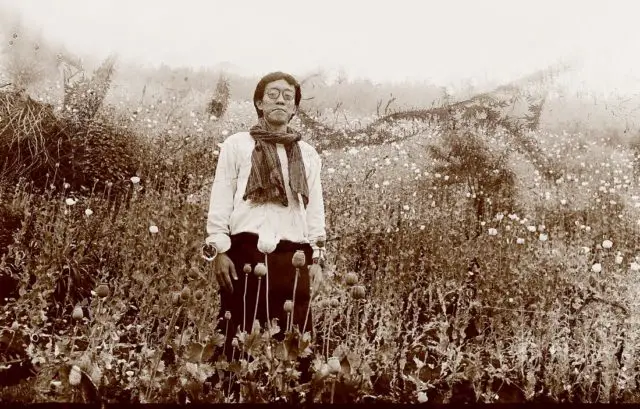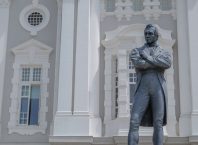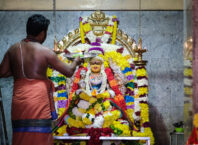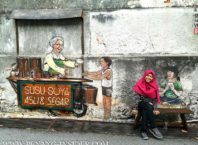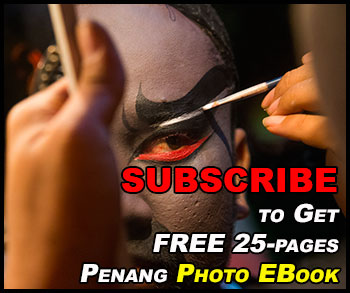Foreign correspondent Kim Gooi, born and bred in Penang, is Malaysia’s least celebrated photojournalist. Very few indeed know about this bohemian Asia old hand, the only Malaysian reporter on the Cambodian frontline. He worked for major TV networks in the US, UK, Australia, Europe, Japan, Hong Kong, and was the stringer for Times Magazine and New York Times. In 1977, he was sentenced to six months imprisonment in the Keng Tung jail of Burma for illegal border trespassing, came out only a year later thanks to the intervention of the Malaysian embassy in Rangoon, and among other key characters of Southeast Asia’s modern history, he met Shan warlord Khun Sa.
It’s all captured in his book, The Poet of Keng Tung Jail – a collection of essays on life in prison, maintaining health through mastering the art of tea, and episodes from the frontlines and most hidden corners of Southeast Asia. Kim Gooi writes with great vibrancy, wit and an uncommon deal of honesty.
One particular scene shows his indomitable character: when incarcerated, he meets Aktar, a powerful and rich Muslim leader who bribed the prison guards to step up from prison hell by receiving home-cooked food and reading materials daily. Aktar invites Kim Gooi to join his group and gives him a copy of The Life History of Prophet Mohammad to read. He hopes that, when he will be released, Gooi will help tell Malaysia’s Prime Minister Tunku Abdul Rahman to stop the killing of Rohingya Muslims in Burma. A couple weeks later, Aktar asks Gooi what he learned about Islam from the book. The answer satisfies the leader: Islam is the most egalitarian and socialist of religions, one that emphasizes solidarity. But Kim Gooi is not finished. He questions Aktar by asking why, then, many women in Islamic nations are treated as inferior. He believes they should be rather considered at the base of Islam because it was wife Khatijah who coaxed the Prophet to return to the mountain and receive the word of god. Aktar can’t tolerate the irreverent question and shouts. But he will never distance this bold, sharp-tongued Malaysian friend.

The Beginnings
Kim Gooi discovered journalism at 21 years old when he met a Dutch freelance photojournalist traveling on a train in Northern Thailand. He started selling his first stories when studying in Singapore, and a couple years later moved to Bangkok to chase his dreams. “When I arrived in the 1970s, Bangkok had opportunities, great food, no traffic jams and way too many available women,” he says. “The US base in Northeast Thailand had just closed down, and many officials had come to live in Bangkok”. That’s how Kim started to make a quirky living: “My first job was letter writer: as I was learning to speak Thai, I helped bar girls read and write letters in English to their johns. At first, they paid me in beer, but when it became too much booze, I started asking for money.”
“I grew up here, and my understanding of the heritage is real. I think that what they have done today is a disaster.
Kim moved to the Thai-Cambodian border. “My arrival was perfectly timed with the Vietnamese invasion of Cambodia. The Khmer Rouge shuttled to the Thai border to recruit people and fight against the Vietnamese,” he remembers. “There were thousands of refugees dying at the border. The BBC, CNN and other Japanese TV stations needed feature stories and documentaries and had big budgets. 200.000 US$ was standard for producing 30-minutes feature documentaries, and everyone wanted to show off and competing with each other to deliver the best coverage,” Kim fondly remembers. “I was the top gun in Aranyaprathet… people like Italian foreign correspondent Tiziano Terzani came only years later. Also, they didn’t speak Thai and depended on interpreters. I was a one-man crew: I started working with TV productions, making as much as 150-200 US$ a day, quite a fortune back then, and all because of a terrible war”.
Trading Bangkok for Penang
In the early 2000s, Kim returned to Penang, where he currently lives. He was one of the first Malaysiakini writers, but gradually abandoned the profession to dedicate himself to his other passions: tai chi and the blues harp. Part of his choice was because of disillusionment with the way journalism had changed since his Bangkok heydays. “The process of writing magazine features has changed a lot. Today, editors ask for only about 500-800 words. It’s too short to expose well researched facts: when you read an article now, you realize that the author has probably talked to a person for only a couple hours, and has written the feature right after. Back then, we sacrificed up to a week per story. Also, journalists today don’t read enough background information and don’t study the culture of the places they cover too well.”

Kim maintains his critical views on Penang. I ask him about George Town’s transformation to UNESCO World Heritage Site. He’s skeptical. “I grew up here, and my understanding of the heritage is real. I think that what they have done today is a disaster. The UNESCO listing was awarded to a ‘living city’. And that means Chinese, Indian Muslims, and Malays, living all together in harmony. It’s not the cookie-cutter boutique hotels and expensive cafés that chased out the original inhabitants and craftsmen from the streets… our ancestors are spinning in their graves.”
More of his tales of wonder and woe and extracts from The Poet of Keng Tung Jail can be read at his blog, where you can contact Kim Gooi or order copies of his book.


